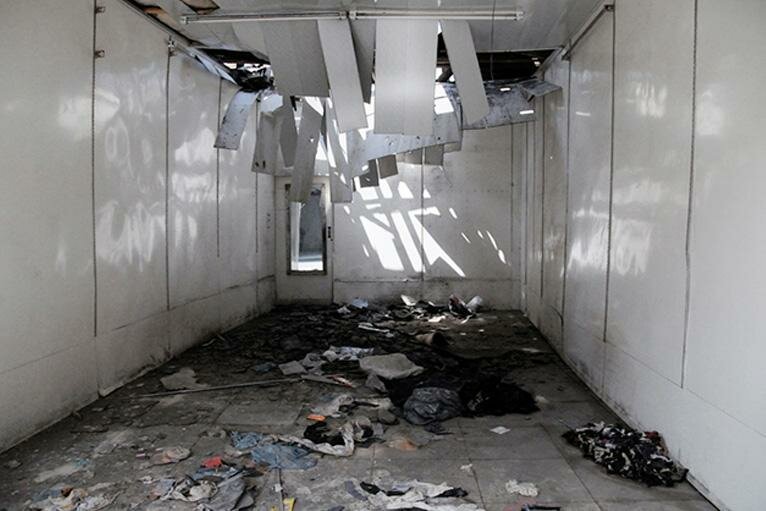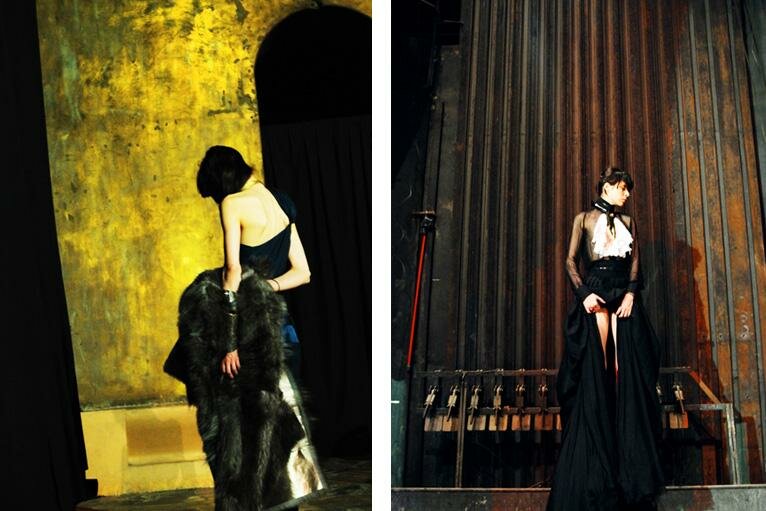- 1
- 2
- next ›
- last »
The publishing industry is changing, and while the masses are calling out 'Print is Dead', Monika Belskyte is telling them its alive and well just as loud. SOME/THINGS Magazine, it's agency and gallery space put a new twist on traditional publishing business models and while other magazines look to reduce the cost of production or increase their revenue from advertising, SOME/THINGS does the opposite by providing a product that is truly collectable and true to the magazines philosophy and direction. I spoke to Monika about the magazine and it's affiliate departments to get her thoughts.
Adam Bryce: Tell me about SOME/THINGS? It’s not just a magazine...
Monika Bielskyte: SOME/THINGS is a multi-disciplinary enterprise comprising of SOME/THINGS magazine, SOME/THINGS agency, SOME/THINGS limite/ditions and SOME/THINGS secret. Currently, we are also developing a new branch, SOME/THINGS films, for the production of highly aesthetic documentary videos.
SOME/THINGS magazine is a curated project in the form of a luxury book. Coming out every 6-9 months, each issue has a distinct conceptual theme and provides extensive insight into its featured contributors, from fields as diverse as art, architecture, fashion, industrial design, and science. Our criteria for choosing the collaborators is the visionary approach of each to their medium. The book doesn’t feature any conventional advertising or news/reviews, instead we create commissioned editorial content which makes no distinction from the artist features.
Our main emphasis is on creating and selecting photographic material that really impacts the mind of the reader, in-depth interviews, and unprecedented intimate visual documentation inside the world of some of the leading creatives, as well as a selection of archive-based projects. The book is printed on the finest recycled paper stock using environmentally responsible luxury production methods, which makes the publication a rather beautiful collectable object.
AB: And about yourself, how did you end up starting SOME/THINGS...where did your interest in art and culture come from?
MB: Creating a magazine/gallery/creative studio was my dream for a long time, but SOME/THINGS was really born as a result of meeting James Cheng Tan, my partner in work and life, who made a lot of previously impossible things happen. So, in the beginning we were this tiny enterprise of two, James taking care of the financial/business aspect and I managed the creative side. It was very exciting but also a rough ride, I must say— the moments when we realized that a dream put into real life is not exactly the same thing as one imagines it to be.
We were incredibly lucky though because, since the first issue, we gained support from such amazing people as Michele Lamy & Rick Owens, Roger Ballen, Zhang Huan, L'Eclaireur etc. By the 2nd issue our current deputy editor Raina Lampkins-Fielder [former associate director of the Whitney Museum and a truly brilliant contemporary art woman] joined our team, which has continually grown since.
The good thing about having tough times early on is that it just keeps getting better. I mean, I've never been happier and never been surrounded by so many wonderful people as I am now. It’s a rather amazing feeling to start each day with excitement, and whenever I am away from the office not only do I feel that I miss the SOME/THINGS team but that they do miss me as well, which I think is a rather rare thing, especially because working with me is not exactly the easiest job out there. I haven’t even spoken about our contributors, some of which have been truly crucial meetings in my life, and without their generosity, support and trust we would certainly not be where we are today.
AB: What was your childhood like?
MB: I come from Lithuania and was born in the soviet times. I grew up during the fall-of-the-wall and post-independence crisis, years of total economic/political disarray. As of my own childhood and teens, I was a very rebellious kid, which certainly didn’t go down well with my family, or with the surroundings.
Let's put it this way, I do not particularly miss those times or those places, I do not have anything to idealize in my past but, at the same time, without these experiences I wouldn’t be where I am today. Again, the good thing about not having an easy childhood is that you are never nostalgic about it, never want or need to go back, but rather want to look forward & run faster than the demons of memory. I think the family/national ties can be crippling sometimes in the case of a creative person. I like this idea of coming slightly from nowhere, it gives a certain sense of freedom.
AB: Your photography..when did you start taking photos? Do you still get to spend as much time as you'd like shooting?
MB: I had my first photography exhibition as a 12-year-old kid in the small town that I come from in Lithuania, and since then photography never really left my life. As a teen, I ran away from home, immersing myself in the world of cinema, assisting young film directors with whatever they needed and doing a little bit of art-direction myself.
At the age of 18, I landed in Paris to study film-directing, only to quit in less than a couple of months, instead continuing my photographic pursuits in India, Nepal, Bhutan, Southeast Asia, China, and South America, among other rather strange places. I worked a lot in post-war, post-natural-disaster zones. There was something about these extreme situations that was attractive to me, that reflected my mind as a mirror. Similarly, the people that interest me the most, even now, are never the easy, glossy characters but real people, who have lived their life to the full, made mistakes, fallen, risen, survived…
Unfortunately, with SOME/THINGS developing so rapidly, at least for now, there is no time left at all for my own photography. So it’s mainly fashion shoots, architecture, cinema, music etc related projects. Not that I can complain about it— with those we have the amazing chance to work with are some of the greatest people out there and the projects we do are unbelievably enriching experiences thanks to them. The fact that we cover so many different fields means that there is never time to get bored or to become over satisfied. It’s like starting every time from a zero point, learning everything new, discovering something we did not know about before, it definitely teaches one to stay humble.
AB: In an era when print media has suffered financially, the magazines, including SOME/THINGS, which have come about in this time, are in my opinion much stronger...why do you think this is?
MB: Yeah, I guess it goes to what I said above, having too much comfort [not speaking about physical comfort here...which I appreciate a lot] in what one is doing makes it somewhat too easy…and when things are too easy then people pay less attention, it becomes too mechanical. I think it’s important to constantly try find new solutions, question oneself and try to make it better and better and better each time. There is no limit to what one can do, whenever you think you cannot do more or give more, you end up discovering in fact you can. There is always more than what our eyes can see or your mind can understand.
AB: Tell me about the agency aspect of SOME/THINGS?
MB: At SOME/THINGS agency we specialize in story-telling and creative strategy, engaging with our collaborators on a very personal level, in order to deliver something truly unique and qualitative at the end of the process. We focus on developing our client's brand/creative identity and image over the long-term, and provide sophisticated visual and conceptual solutions throughout. Interlinking a diverse range of mediums and utilizing our creative associations and background knowledge in photography to find the most consistent ways to explore the brand's— or a particular creative's history, and document the complex design, production, research, and technological processes. One of my main requests towards my team is to ensure the perfect execution down to the smallest details. I feel that today, in communication, it is truly essential to have a fresh approach— hence creating new encounters, finding a new way to see and new way to present things is crucial.
AB: You're a creative person, specifically someone with a visual creative orientation, running a business - people say those things don't meld together well. How do you find a balance and make it work?
MB: Thank god I do not have to deal with the business side at all! I think I would go crazy if I did. Luckily, James is doing that. I’m lucky enough to have associates that I really admire and that protects me from a number of business related headaches. I think it is essential to work with people that you have confidence in— better a small team that you can trust, even if it means not being able to do everything you’d like to do, than a big one that permits you doing everything, yet only half as well.
AB: Tell us about SOME/THINGS secret?
MB: SOME/THINGS secret is a dynamic experimental space rather than a conventional gallery, a bit like a physical extension of SOME/THINGS magazine, exhibiting works featured within its pages as well as projects and pieces commissioned exclusively for SOME/THINGS. The secretive aspect of it is due to the fact that it is also our creative studio, a place where the content of the magazine is being put together. So, coming inside it is not like going into a white cube where you are greeted by a random reception girl. It’s really like coming into our own little world. Both the space itself and what’s in it is extremely personal, a subjective vision, just like most of the other things we do.
AB: I understand you have plans to create more editions and objects with artists under the roof of SOME/THINGS. Tell us about your goals for this?
MB: It all happens really organically...it’s hard to predict things. The agency and magazine are our very structured parts, whereas the gallery space and limite/ditions are really like a fun side-project thats we have to fully enjoy doing. Just recently, designer Boris Bidjan Saberi edited a series of bags specially for SOME/THINGS, in which our editions can be carried [the books are so big & heavy, nearly 2 kg each, so to put all of them in a bag it better be sturdy!]. It all happened through a conversation I had with Boris in his studio in Barcelona. I was complaining that I couldn’t find anything suitable for carrying my camera, since I always disliked the standard photographic equipment bags. So he came up with a very cool idea, it’s super multifunctional, very BBS, very SOME/THINGS, we are really happy with it.
The upcoming project on which I am working is a collaboration for a jewelry/art project with my dear friend, and our chapter005 editorial woman, Nora Renaud. We are working hard to get it ready for an exhibition in March. They’re really amazing pieces, very organic, very sensual, almost a bit dangerous. I wear the prototypes all the time and everyone's loving them. It’s amazing to see them growing, developing, becoming the final thing right in front of our eyes, since nora is, in fact, working in our office— she's got her own part of the space and she does all the stuff here. So that illustrates how personal it gets sometimes, I really love this sense of a family, friendship, community that connects us to some of our collaborators.
Some other publications we are currently working on now, such a book for one of the world’s leading contemporary design galleries, or a monograph for one of the greatest architects of the 20th century, are part of SOME/THINGS agency projects.
AB: I've spoken to a lot of artists lately about how the dark visual nature of their work has very positive underlying concepts. SOME/THINGS has a dark aesthetic, in terms of fashion, art, and art direction. Tell us about why this world stands out to you above something brighter or more traditional in it's approach to fashion?
MB: I think there is a lot of misconception about 'darkness'. I mean, darkness is as relevant as lightness. To be serious is as important as having a good sense of humor. People think Rick Owens is dark. He is not dark. He just has his own vision, which is different from what the mainstream is, or at least what it was a couple of years ago. I think as soon as one does something different, something with a bit on the edge, people are ready to label it as a dark, nihilistic, negative, rebellious approach. I don’t like the negativity, but I don’t like the positivity either. I like to see and present things as they are, just in a slightly more special way and a bit more of an exquisite shape.
I do believe beauty lies in unexpected places and people who are considered 'dark' are often enjoying life much more than the overly optimistic characters. I think it comes down to what you make of your experiences - and if you recognize the fact that all of us contain inside ourselves more than what we tend to present to the outer world.
AB: In your opinion - who do you think are the names to look out for over the coming months. Whether they be in fashion, art, or business?
MB: I'd love to give it away for you but, since our next issue's lineup is still confidential, if i name people now it would become too obvious. Also, I am not that crazy about the 'what’s new, who's new' thing. Some of the older people or works are often more a source of inspiration than the new-kid-on-the-block. I mean, working with a 90-year-old Claude Parent is truly a learning experience. Seeing somebody who crossed the entire century yet is still a child at heart— curious, open, resourceful— is really amazing.
If I really have to name— Nora's project will be unveiled on the blog very soon, it’s really exciting. We are also shooting with Bradley Soileau, who for me seems one of the most interesting male models at the moment and I think the editorial we are doing in collaboration with Boris Bidjan Saberi should be very special. Also Nicolas Jaar, who played at our last event with Linda Farrow and BBS at Silencio, is one of the best in his genre, and yet so young!
AB: How has the internet played a role in SOME/THINGS. But also in your own creative development?
MB: In the very early stage with the magazine, the internet was crucial to get us known worldwide— I mean, now we are in 25 countries, back then we were maybe in just 5 shops. So, the only way for us to find our readership, or the readership to find us, was online. We are still grateful for the people who shared the information about us back then when no one cared that much.
I love the fact that such an array of information is accessible in a matter of seconds today. My research assistants spend days researching artists works for me, whereas without the internet it would take them weeks, if not months, to find all the necessary sources that we use in order to prepare a feature. So yeah, I really love the freedom that it has brought us.
In terms of SOME/THINGS’ own development... I am quite divided. The online part is super exciting, and James is really pushing me to give more and more attention to it— we have been working very intensely on the blog, we are currently developing an app, and of course constantly updating Facebook, Twitter etc. But sometimes it does feel like too much, and quite distracting, to deal with so much different stuff when you would just like to close down and spend one week properly preparing a feature/project/shoot. One has to learn to work in the most effective way possible, use up every hour, minute, second. It’s not very healthy, but I guess that’s part of the game.
AB: Whats the future of the way we view, see, and take in media in your opinion?
MB: I am not sure I have an opinion that is by any means universal. I am biaised, I look from my own point of view and can only speak about our own readership or our own way to be ‘the media’— if you can even call us that…
What I feel is there will be a wider and wider gap between low and high quality— very few things in between. In this media over-saturation one only has two choices— either you go mass, or you go top. Going mass is easier but I like the quality, so I guess we will stick with the niche— but this niche is growing, and it’s becoming truly worldwide, with all these new markets opening up. I think the international aspect is extremely exciting, to break out of the Paris/London/New York beaten track. I think working with people from different backgrounds is essential to keep oneself awake to the opportunities of growth that aren’t conventional business strategies to be bigger and make more money, but rather manage to make things more qualitative, more extensive, and more exciting not just for the client but also for yourself.
Adam Bryce



end













































